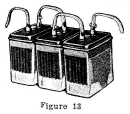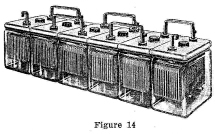To give a little reserve, you should figure your battery somewhat large. For example, a 200 ampere hour battery should be charged after 150 ampere hours are drawn out. That way the battery would carry a 25 watt, 6 volt bulb for 37 1/2 hours without growing dim. However, if the full 200 ampere hours are drawn out, the lamp will burn about 50 hours, but will be very dim when the battery is discharged. Eventually the battery may become damaged.
By referring to the chart above, you can figure the ampere drain on your battery. For example four 15 watt, 6 volt lights and a radio will draw about 12 amperes. Thus a 200 ampere hour battery, supplying 75% of its capacity, will carry the load for 12 1/2 hours, provided the battery was fully charged to start with
To carry through periods of calm, which in some locations last a week or 10 days, you should have enough capacity to carry the load for 10 days. Since all depends on the number of hours you have lights and play the radio, this cannot be figured for you. In the average home and with average wind conditions, you should have 360 to 450 ampere hours of storage capacity on 6 volts, or 180 to 225 ampere hours on 12 volts, since 12 volt equipment draws half the amount of current.
The average automobile battery has a capacity of 100 ampere hours. In most localities 3 or 4 six volt batteries would be used with a 6 volt plant. For a 12 volt installation either 2 or 4 six volt batteries would be required.
Glass jar batteries of the type used on 32 volt systems are very practical. They can be obtained in several ratings. Three cells are often used on 6 volts and 6 cells are required for 12 volt plants. Figure 13 shows a 6 volt installation, and Figure 14 shows a 12 volt installation.


You should check the water level of the batteries every two weeks. Keep the plates covered with one-half inch of distilled water. Never use anything but distilled water. It can be bought at drug stores, garages or filling stations. To be sure of the condition of the battery, but a hydrometer and follow the instructions that come with it. Test the batteries once a week.
As time passes, the positive terminal of the battery will corrode. This corrosion can be partly eliminated by first covering battery terminals and battery clips with vaseline or light cup grease. To thoroughly clean the battery post, sprinkle a small amount of ordinary baking soda on the corroded part and pour on a little water. This will loosen the corrosion so it can be wiped off. In extreme cases repeat the process. Do not allow baking soda or cleaning water to get into the battery.
Positively do not allow generator to run when disconnected from battery or instrument panel. To do so will burn out the generator. Pull plant out of gear, and short circuit the generator by connecting the battery clip on the "Bat -" connection to the "Gen +" terminal of the instrument panel as shown in Figure 15.
If the instrument panel is removed, connect the "Gen +" and "Gen -" wires together.Do not try to charge batteries without the instrument panel or while relay is removed.
| << Previous Page | Return to Home Page | Next Page >> |